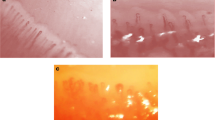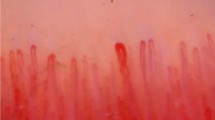Abstract
Kawasaki disease (KD) is associated with generalized vasculitis with a predilection for coronary artery leading to ectasia and aneurysm in some cases. The aim of this study was to noninvasively assess the cutaneous microcirculation and correlate it with the coronary artery diameter in these patients. Laser Doppler flowmetry and dynamic capillaroscopy were performed at the nailbeds to assess total cutaneous blood flow and microcirculation in children with KD, both in the afebrile phase (after the resolution of fever) and convalescent phases, in comparison to controls. The 100 subjects analyzed in this study included 64 patients with KD (33 in afebrile phase and 31 in convalescent phase) and 36 normal controls. In KD, the capillary morphology was abnormal when compared to controls, with a larger diameter of the arterial and venous limbs, a higher intercapillary distance and a decrease in the loop numbers. Significantly decreased capillary blood cell velocity was noted in afebrile phase but not in convalescent phase. In the afebrile phase, a decreased capillary blood cell velocity significantly correlated with an increased coronary artery diameter. In conclusion, KD patients, both in the afebrile and convalescent phases, exhibited morphologic alterations in the microcirculation when compared to the controls. The results indicate the potential role of dynamic capillaroscopy for the noninvasive survey of microcirculation abnormalities in patients with KD.


Similar content being viewed by others
References
Kato H, Ichinose E, Yoshioka F et al (1982) Fate of coronary aneurysms in Kawasaki disease: serial coronary angiography and long-term follow-up study. Am J Cardiol 49:1758–1766
Newburger JW, Takahashi M, Gerber MA et al (2004) Diagnosis, treatment, and long-term management of Kawasaki disease: a statement for health professionals from the Committee on Rheumatic Fever, Endocarditis, and Kawasaki Disease, Council on Cardiovascular Disease in the Young, American Heart Association. Pediatrics 114:1708–1733
Sohn S, Kwon K (2008) Accelerated thrombotic occlusion of a medium-sized coronary aneurysm in Kawasaki disease by the inhibitory effect of ibuprofen on aspirin. Pediatr Cardiol 29:153–156
Liu AM, Ghazizadeh M, Onouchi Z et al (1999) Ultrastructural characteristics of myocardial and coronary microvascular lesions in Kawasaki disease. Microvasc Res 58:10–27
Cicala S, Galderisi M, Grieco M et al (2008) Transthoracic echo-Doppler assessment of coronary microvascular function late after Kawasaki disease. Pediatr Cardiol 29:321–327
Furuyama H, Odagawa Y, Katoh C et al (2003) Altered myocardial flow reserve and endothelial function late after Kawasaki disease. J Pediatr 142:149–154
Muzik O, Paridon SM, Singh TP et al (1996) Quantification of myocardial blood flow and flow reserve in children with a history of Kawasaki disease and normal coronary arteries using positron emission tomography. J Am Coll Cardiol 28:757–762
Hamaoka K, Onouchi Z, Kamiya Y et al (1998) Evaluation of coronary flow velocity dynamics and flow reserve in patients with Kawasaki disease by means of a Doppler guide wire. J Am Coll Cardiol 31:833–840
Colberg SR, Parson HK, Nunnold T et al (2006) Effect of a single bout of prior moderate exercise on cutaneous perfusion in type 2 diabetes. Diabetes Care 29:2316–2318
Kurio GH, Zhiroff KA, Jih LJ et al (2008) Noninvasive determination of endothelial cell function in the microcirculation in Kawasaki syndrome. Pediatr Cardiol 29:121–125
Schwartz RW, Freedman AM, Richardson DR et al (1984) Capillary blood flow: videodensitometry in the atherosclerotic patient. J Vasc Surg 1:800–808
Norman M, Herin P, Fagrell B et al (1988) Capillary blood cell velocity in full-term infants as determined in skin by videophotometric microscopy. Pediatr Res 23:585–588
Albrecht HP, Hiller D, Hornstein OP et al (1993) Microcirculatory functions in systemic sclerosis: additional parameters for therapeutic concepts? J Invest Dermatol 101:211–215
Chang CH, Yu HS, Chen GS et al (1996) Deterioration of cutaneous microcirculatory status and its clinical correlation in tetralogy of Fallot. Microvasc Res 51:59–68
Winsor T, Haumschild DJ, Winsor DW et al (1987) Clinical application of laser Doppler flowmetry for measurement of cutaneous circulation in health and disease. Angiology 38:727–736
Maricq HR (1981) Wide-field capillary microscopy. Arthritis Rheum 24:1159–1165
Masuda H, Kawamura K, Nanjo H et al (2003) Ultrastructure of endothelial cells under flow alteration. Microsc Res Tech 60:2–12
Dobbe JG, Streekstra GJ, Atasever B et al (2008) Measurement of functional microcirculatory geometry and velocity distributions using automated image analysis. Med Biol Eng Comput 46:659–670
Acknowledgments
The authors would like to thank Dr Kung-Kai Lin and Dr Hsin-Su Yu for their technological assistance.
Disclosures
None.
Author information
Authors and Affiliations
Corresponding authors
Rights and permissions
About this article
Cite this article
Huang, MY., Huang, JJ., Huang, TY. et al. Deterioration of cutaneous microcirculatory status of Kawasaki disease. Clin Rheumatol 31, 847–852 (2012). https://doi.org/10.1007/s10067-012-1948-x
Received:
Revised:
Accepted:
Published:
Issue Date:
DOI: https://doi.org/10.1007/s10067-012-1948-x




